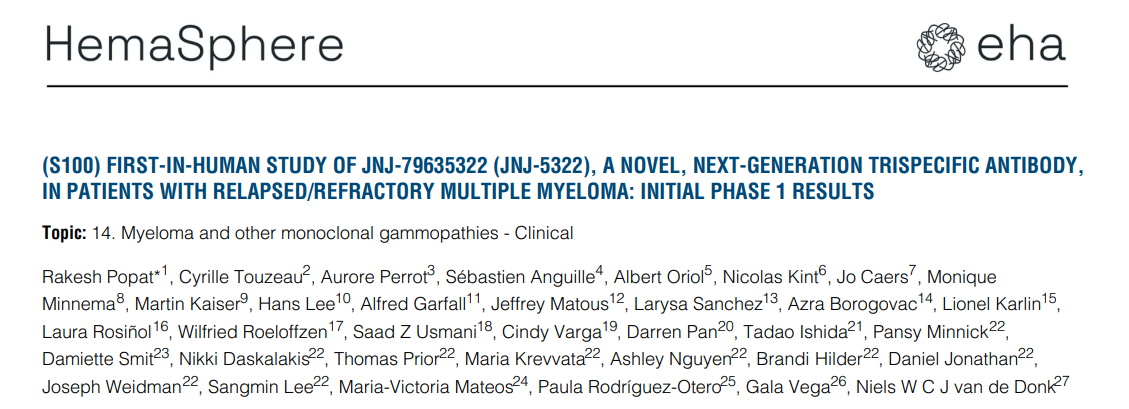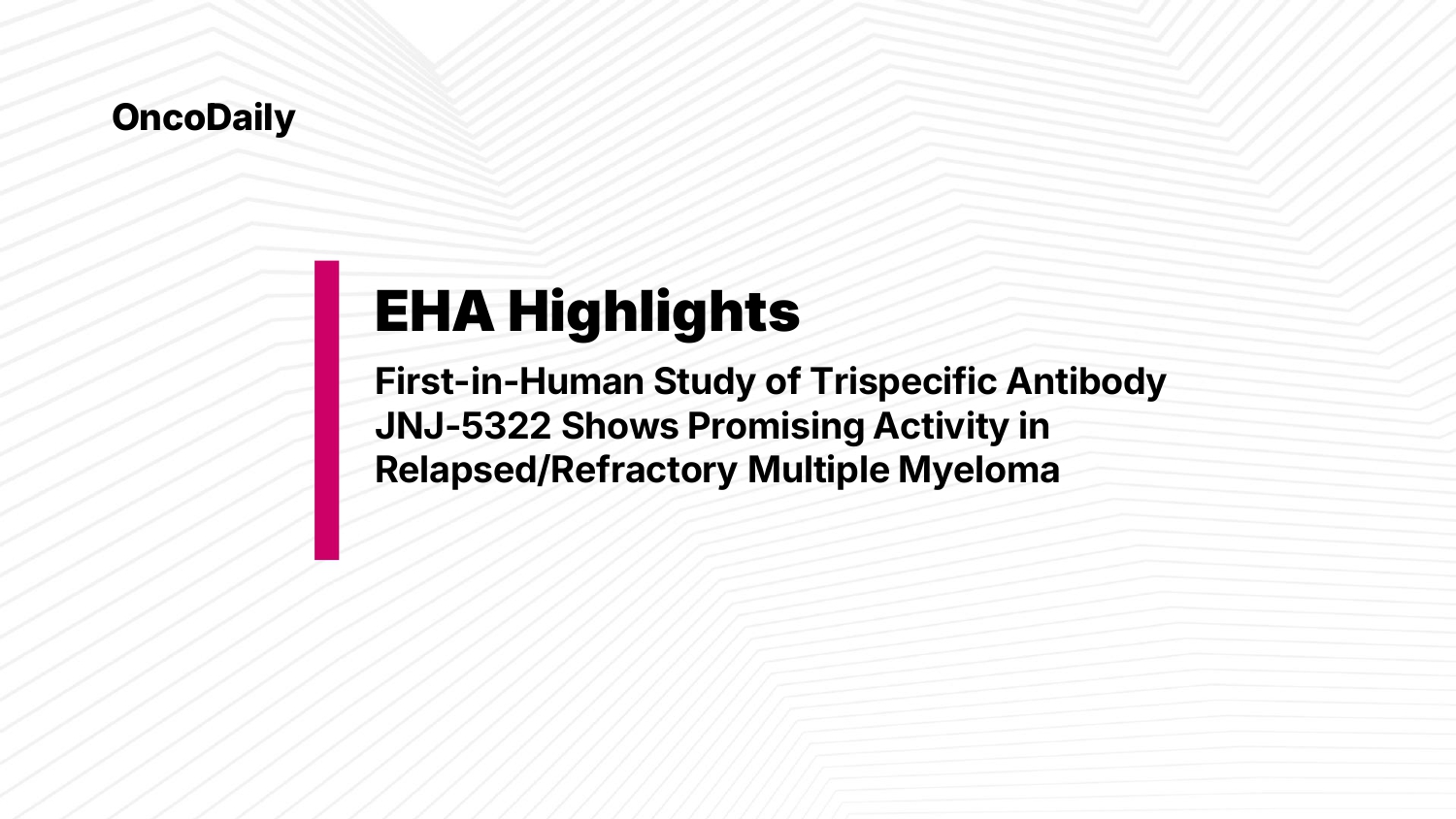JNJ-79635322 (JNJ-5322) is a novel, next-generation trispecific T-cell redirecting antibody designed to improve outcomes in relapsed/refractory multiple myeloma (RRMM) by simultaneously targeting BCMA, GPRC5D, and CD3. Developed to address the challenges of tumor heterogeneity and acquired resistance seen with bispecific antibodies, JNJ-5322 features dual antigen targeting and a low-affinity CD3 binding domain optimized in vitro to enhance antitumor activity while reducing off-tumor toxicity.
Initial clinical data from the ongoing Phase 1 trial (NCT05652335), presented by Dr. Rakesh Popat at both EHA 2025 and ASCO 2025, highlight promising efficacy—including high response rates even in heavily pretreated patients—and a favorable safety profile, supporting its potential as an off-the-shelf immunotherapy option for RRMM.

Background
Bispecific antibodies (BsAbs) have significantly advanced outcomes in relapsed/refractory multiple myeloma (RRMM) by redirecting T cells against tumor antigens. However, tumor heterogeneity and acquired resistance continue to limit their long-term efficacy. Emerging evidence suggests that targeting multiple myeloma-associated antigens simultaneously through T-cell redirection could help overcome these resistance mechanisms and improve clinical outcomes.
JNJ-5322 is a next-generation trispecific antibody designed to dually target BCMA and GPRC5D while engaging CD3 on T cells. It incorporates novel binding domains, including a low-affinity CD3 component selected through in vitro screening to enhance on-tumor effects and minimize off-tumor toxicity. This mechanism aims to deliver potent T-cell–mediated cytotoxicity while reducing adverse events associated with nonspecific immune activation.
Study Design and Methods
This Phase 1, dose-escalation/expansion trial enrolled patients with measurable RRMM who were previously exposed to a proteasome inhibitor, immunomodulatory agent, and anti-CD38 monoclonal antibody. Patients received subcutaneous JNJ-5322 every 2 or 4 weeks (Q2W/Q4W) at escalating doses ranging from 0.4 to 300 mg.
The putative recommended Phase 2 dose (RP2D) was identified as 100 mg Q4W, following a step-up dose (SUD) of 5 mg to reduce cytokine release syndrome (CRS). Adverse events were assessed per CTCAE v5.0, with CRS and ICANS graded per ASTCT criteria. Efficacy was evaluated using IMWG response criteria.
Patient Population
- 126 patients received JNJ-5322, including 36 at the RP2D
- Median age: 64 years
- Median prior lines of therapy:
- 100% triple-class exposed, 56% triple-refractory
- 31% had high-risk cytogenetics
- 23% had prior anti-BCMA/GPRC5D therapy
Results
As of the data cutoff on January 15, 2025, a total of 126 patients with relapsed/refractory multiple myeloma received JNJ-5322 across escalating dose cohorts, including 36 patients treated at the putative recommended Phase 2 dose (RP2D) of 100 mg every 4 weeks (Q4W). Patients were heavily pretreated, with a median of four prior lines of therapy, and all were triple-class exposed.
Safety:
- 99% experienced at least one AE
- CRS: 59% (all grade 1/2; no grade ≥3); reduced by single SUD
- Nail and taste AEs: 56% (grade 1/2)
- Neutropenia: 48% (grade 3/4 in 41%)
- Skin AEs (non-rash): 47%
- Infections: 75% (grade 3/4 in 28%)
- ICANS: 2% (all grade 1)
- Dose-limiting toxicities: 5 patients
- AE-related deaths: 4 patients
Efficacy:
- Overall ORR: 73% (n=124), with 66% ≥VGPR
- At RP2D (n=36): ORR 86%, with 75% ≥VGPR
- Among anti-BCMA/GPRC5D-naïve patients at RP2D (n=27):
- ORR: 100%, with 89% achieving ≥VGPR
- All remain in response at median follow-up of 8.5 months
- Median time to response: 1.2 months
Key Takeaways
JNJ-5322 is a promising off-the-shelf trispecific antibody offering robust efficacy and manageable safety for heavily pretreated RRMM patients. Its 100% response rate in naïve populations, combined with the convenience of monthly subcutaneous dosing, may mark a paradigm shift in myeloma immunotherapy, offering CAR-T-like efficacy without the complexity of cell therapy.
- JNJ-5322 shows high clinical activity, including 100% response rate in antigen-naïve patients.
- The tolerability profile appears favorable, with low-grade CRS and manageable infections.
- Off-target effects commonly associated with GPRC5D targeting (e.g., nail/taste AEs) were milder compared to previous bispecifics.
- Step-up dosing minimized CRS without the need for inpatient care.
You can read the full abstract here.
Written by Sona Karamyan, MD
